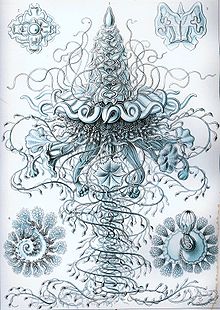Physonectae
| Physonectae | |
|---|---|

| |
| illustration of Physophora hydrostatica | |
| Scientific classification | |
| Kingdom: | Animalia |
| Phylum: | Cnidaria |
| Class: | Hydrozoa |
| Order: | Siphonophorae |
| Suborder: | Physonectae Haeckel, 1888[1] |
| Families[2] | |
| |
Physonectae is a suborder of Siphonophores. In Japanese it is called 胞泳[3] (hōei).
Like all siphonophores, members of Physonectae are composed of a colony of zooids. Physonect species typically have a pneumatophore (float) at the top, with a nectosome region beneath it.[2][4] The nectosome has many nectophores, or swimming bells,[2] that propel the colony in any direction.[4] The only exception are species in the genus Athorybia, which lack nectophores,[2] resembling members of Cystonectae. Past the nectosome is the siphosome, which contains hydrophyllia (protective bracts), gastrozooids (feeding polyps), gonophores (reproductive medusae), and (polyps with suspected defensive and/or excretory functions).[2][4] These structures in the siphosome repeat in a pattern which is different for each species.[4] Each loop on the pattern is called a cormidium.[4]
References[]
- ^ Haeckel, E. (1888). System der Siphonophoren auf phylogenetischer Grundlage entworfen. Jenaische Zeitschrift für Naturwissenschaft. 22: 1-46., available online at http://www.biodiversitylibrary.org/item/43887#page/11/mode/1up page(s): 38
- ^ Jump up to: a b c d e Schuchert, P. (2019). World Hydrozoa Database. Physonectae. Accessed through: World Register of Marine Species at: http://www.marinespecies.org/aphia.php?p=taxdetails&id=135335 on 2019-03-11
- ^ Japan Agency for Marine-Earth Science and Technology. (2009 onwards). Biological Information System for Marine Life (BISMaL). Accessed on 2018-11-21. available online at http://www.godac.jamstec.go.jp/bismal
- ^ Jump up to: a b c d e Dunn, Casey. "Siphonophores: Body Plan". Siphonophores. Retrieved 11 March 2019.
- Siphonophorae
- Cnidarian suborders
- Taxa named by Ernst Haeckel
